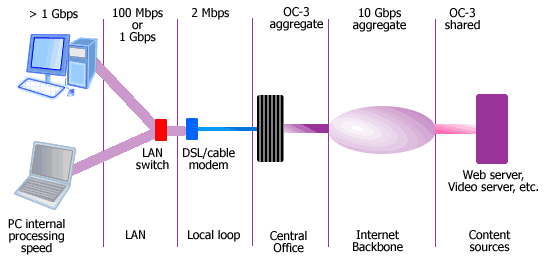Internet Access Guide : Fiber-To-The-Home (FTTH)
How much data rate a FTTH subscriber can get? It depends
on the architecture of the ODN, the capacity provided per optical
interface in the CO, and the number
of subscribers served by the optical module in the CO. Like
DSL/cable, FTTH is offered in several service levels. It is
usually in different download/upload (DL/UL) rates
and/or bundled services. The DL/UL rates are usually higher than
DSL/cable rates, e.g. 15 - 30 Mbps for
download and 2 - 5 Mbps for upload. The DL/UL rates may be adjusted
over time by FTTH service providers based on competition and bandwidth requirement of popular applications.
However, a FTTH subscriber must remember that the quoted DL/UL
speeds apply only to the link between him/her to the service provider's PoP.
Say for instance, you visit a website stored in a
Web hosting server
somewhere on the Internet, the bandwidth pipe that connects the
said Web server to the Internet also affects your download speed.
And the fact that the pipe is also shared among all other visitors
will become another factor that affects your download speed. So, in many cases
you would end up getting lower DL/UL rates than those stated in
commercials.

Picture: End-to-end bandwidth pipe
Real download and upload rates depend on the available end-to-end
network capacity.
In a typical home network, a Fast Ethernet backbone has
symmetrical transfer
rate of 100 Mbps, while average DSL/cable modem download rate is
below 2 Mbps and upload rate is lower than that. The capacity ISPs or network operators
have in their backbone is in giga bits per
second (Gbps) order and moves toward tera bits per second (Tbps).
So, the last mile (DSL/cable) becomes a
bandwidth bottleneck. FTTH lowers the bandwidth gap between a subscriber
LAN (and his/her PC's internal processor) and
the Internet.
FTTH enables the delivery of multimedia applications in very
good quality, such as video and photo sharing, telemedicine,
telecommuting, distant learning, and video monitoring. Each type
of application has a unique bandwidth (read: capacity)
requirement. For example, a HDTV requires 15 - 20 Mbps, HSI (high
speed Internet) 5 - 10 Mbps, and a POTS 64 kbps. FTTH also has
lower latency and less jitter than other access methods that makes
it very suitable for real-time application, such as VoIP and
interactive game.
|